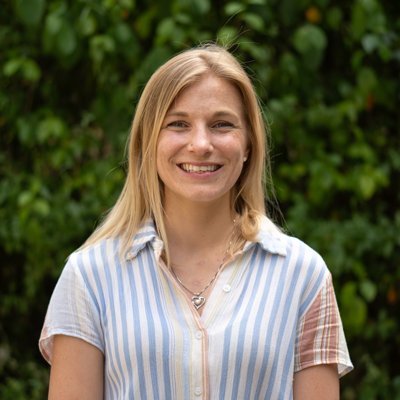
After receiving her doctorate in biochemistry in 2019, Erin Aboelnour was no way near finished with asking questions about how human beings develop on a cellular level. Luckily, epigenetics and neuroscience are full of fascinating questions.
What causes humans to develop differently from each other? What kinds of diseases are preventable with cellular manipulations? How do proteins function within a cell? With these and other questions in mind, Aboelnour, now a postdoctoral researcher in the Department of Biological Sciences at the University of Notre Dame, found herself moving to Munich to answer them.
There, she studied brain development in mammals — only speaking German in random words and phrases that she learned, such as “pregnant mice,” Aboelnour described with a laugh. She explored the genetic and epigenetic processes that contribute to building the cortex, the evolutionarily newest area of the mammalian brain, which is responsible for critical functions like memory, emotions, language and higher-order cognition.
In the fall of 2023, Aboelnour joined the research lab of Katrina Adams, Gallagher Assistant Professor in the Department of Biology. She was interested in Adams’s lab because “she is really strong in cellular neurobiology, and with my interest in single cell techniques, epigenetic and genetic research, we would be able to meld together these two worlds and create some super exciting projects,” Aboelnour said.
Her recent work looks at pursuing novel treatments for Multiple Sclerosis (MS), which occurs when oligodendrocytes, a type of glial cell, become damaged. “MS is especially common in women, so it is really great to tackle challenges that relate to gender as well,” says Aboelnour.
In the research process, Aboelnour relies on mouse models of MS and access to patient brain samples to describe new disease-relevant pathways. “We study how these changes are occurring and contributing to MS and other demyelination diseases, and hopefully identify new targets that could be druggable or potentially help treat patients, even at later stages in the disease.”
One key to working in a lab is to find a support network, Aboelnour said. There are so many challenges, some of which transcend neuroscience research. For instance, while in Germany, Aboelnour and her husband welcomed their daughter.
“Becoming parents in Germany was such an experience . . . the research is intensive, and it was a constant challenge on where to balance time and resources,” she said.
The opportunities at Notre Dame have provided Aboelnour and her team with the ability to make real progress.
“The facilities in Galvin [Life Science Center] are awesome,” said Aboelnour. “We have our own surgery room, and places to work with the animal samples to do really high-level research. We have access to the equipment for single cell techniques, including these beautiful tools for spatial analysis for complex tissues. There are only a few, 10 or so, instruments in the country, and we actually have one. I am really excited to have access to this equipment which allows us to ask some really cutting edge questions about these different diseases.”
Aboelnour is enjoying getting to know Notre Dame and the South Bend area, noting that it has exceeded expectations. She and her husband are “enjoying exploring the community while being parents,” she said.
“A shoutout also to the genomics core for the great support to help get our projects going, and our bioinformatician, as well as the CRC resources. I want to thank them for helping get me set up here; it has been amazing.
Science has such a fantastic international community — it is very cool to be a part of,” she said.